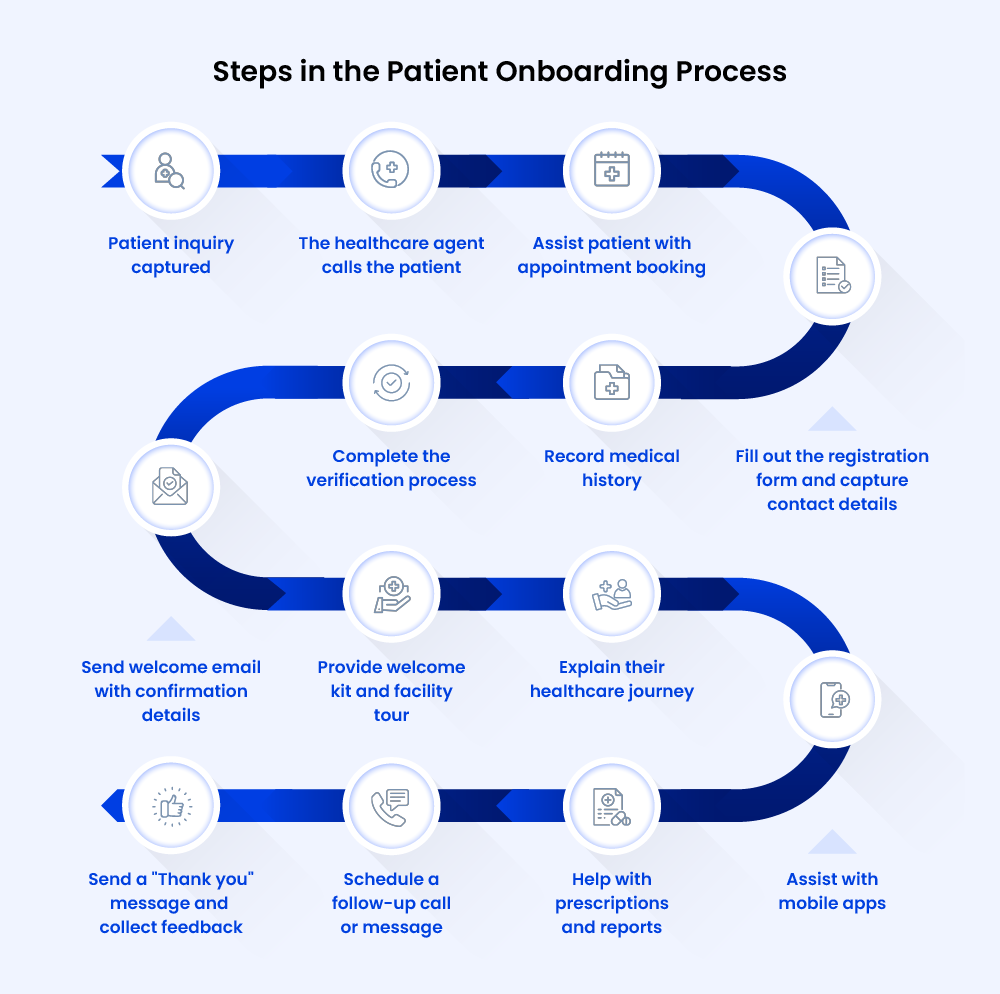As a healthcare provider, you know how important it is to create a positive experience for your patients from the moment they walk through your doors. One crucial aspect of this experience is the onboarding process.
This is where patients register for their appointments, share their medical history, and sign consent forms. It’s a critical step in the patient’s journey and sets the tone for the rest of their visit.
Therefore, a streamlined digital onboarding process will improve patient experience, increase team productivity and patient intake, and boost overall organizational growth.
In this blog, we will cover everything related to patient onboarding (or patient intake process).
Let’s begin by understanding the basics of patient onboarding.
What Is Patient Onboarding?
Patient onboarding is when, for the first time, a patient enters your healthcare facility and the front office staff records their details and medical history. A smooth and streamlined patient onboarding process helps improve patient experience and staff productivity.
While patient registration is a crucial first step, many mistakenly equate it with the onboarding process.
Patient onboarding is a broader process that not only focuses on the paperwork of patient registration but also introduces and welcomes the patient into the healthcare journey with your hospital.
Process | Patient registration | Patient onboarding |
Focus | Gathering basic information and administrative tasks | Welcoming, educating, and building trust |
Activities | Collecting demographics, verifying insurance, assigning a patient ID, and setting up communication channels | Providing information about the practice, explaining policies and procedures, answering questions, and offering resources |
Outcome | Establishing the patient in the system and creating their medical record | Building a positive patient-provider relationship and ensuring the patient feels comfortable and informed |
Timing | Typically, the first point of contact, often before any clinical interaction | Can occur before, during, or after registration, and may continue over multiple interactions |
Example | Filling out intake forms at a doctor's office before your first appointment | Receiving a welcome call from the clinic after your first appointment, attending a new patient orientation session, or accessing educational materials through a patient portal |
Now that we understand the essential components of patient onboarding, let’s delve into a practical checklist to ensure a smooth and seamless transition for your new patients.
The Patient onboarding checklist serves as a comprehensive guide to ensure all necessary steps are covered during the patient onboarding process, streamlining the overall healthcare experience.
Let us have a bird’s eye view of the patient onboarding process.

Now that you know what patient onboarding and various stages are, let’s look at the challenges in the process.
5 Key Challenges in Patient Onboarding
Here are the top 5 challenges faced mainly by healthcare providers and patients during the onboarding processes at healthcare facilities:
- Too much paperwork: Filling out tons of paper forms takes a lot of time for both patients and staff. It can also lead to mistakes and wasted resources, like paper and ink. This can slow things down and make it harder to provide the best care.
- Scattered information: Patient information is often spread out across different systems and records, making it hard to find when needed. This can cause delays, confusion, and missed opportunities to provide the best possible care.
- Confusing language: Medical terms and complicated forms can be hard for patients to understand, which can make them feel anxious and less likely to ask important questions. This can make it harder for them to follow treatment plans and feel confident in their care.
- Limited access and flexibility: Patients often have to go to the clinic in person just to fill out forms or complete tasks, and they may only be able to do this during certain hours. This can be inconvenient for those with busy schedules or transportation challenges.
- Technology challenges: Switching to digital onboarding can be costly and requires staff training. It’s also important to protect patient privacy and security when using new technology. This can be a big change for everyone involved, and it needs to be done carefully.
Luckily all these challenges can be resolved by implementing a digital onboarding process. Apart from these challenges, a patient onboarding process also largely benefits the patients and healthcare providers. Let’s look at how.
Benefits Of Digital Onboarding Process
Let’s dive deeper into the benefits of a digital patient onboarding process, both for patients and healthcare providers:
For Patients:
- Convenience and flexibility: Imagine filling out forms from the leisure of your home instead of filling out pages in a waiting room. Digital onboarding allows patients to complete tasks at their own pace, on their own schedule, regardless of physical location. This can be especially helpful for busy individuals, parents juggling childcare, or people with medical conditions that limit mobility.
- Reduced wait times: Traditional onboarding involves filling out paper forms, waiting for data entry, and verifying insurance. Digital portals automate these tasks, significantly reducing wait times at the clinic. This is a win-win, allowing patients to spend less time waiting and providers to see more patients efficiently.
- Improved accuracy and completeness of information: Paper forms are prone to errors due to handwriting, typing errors, or missing information. Digital forms can utilize auto-fill features based on existing data, validate entries in real-time, and prompt for missing information, leading to more accurate and complete patient data. This benefits both patients and providers, as accurate data ensures proper diagnosis, treatment, and billing.
- Enhanced engagement and education: Online portals can be educational hubs, offering informative materials about the patient’s condition, upcoming procedures, or general health advice. This empowers patients by equipping them with knowledge and reducing anxiety, leading to better communication and collaboration with their healthcare providers.
- Greater control over personal health information: Secure online portals allow patients to access and manage their medical records at their fingertips. They can view appointments, test results, medication lists, and communicate with their providers directly. This fosters a sense of ownership and control over personal health information, empowering patients to actively participate in their healthcare journey.
For Healthcare Providers:
- Increased efficiency and productivity: With digital onboarding, manual data entry, and administrative tasks are automated, freeing up staff time to focus on providing direct patient care, consultations, and follow-up. This improves workflow, increases employee satisfaction, and allows for better patient relationships.
- Improved data quality and accessibility: Digital records are stored electronically, centralized, and readily accessible to authorized personnel. This eliminates the risk of lost paperwork, ensures easy data sharing for informed decision-making, and facilitates better coordination of care between different healthcare professionals involved in a patient’s case.
- Enhanced patient satisfaction: When patients experience a smooth, efficient, and informative onboarding process, their overall satisfaction with the healthcare provider increases. This leads to positive reviews, stronger patient loyalty, and potential recommendations to others.
- Reduced costs: Manual processes involve printing, storing, and retrieving paper forms, which can be costly and time-consuming. Digital onboarding eliminates paper usage, minimizes data entry errors, and streamlines administrative tasks, resulting in significant cost savings for healthcare organizations.
- Greater reach: Online portals can be accessed by patients from anywhere, anytime, even in rural areas or during off-hours. This increases patient reach, allows for remote consultations, and caters to individuals with limited mobility or transportation access.
By implementing a digital patient onboarding process, healthcare providers can transform the initial experience for both patients and staff. It paves the way for a more efficient, patient-centered, and cost-effective healthcare system that prioritizes well-being and information for everyone involved.
And the best way to build a digital onboarding process to avail all the benefits is by implementing patient onboarding software. Below we have listed the top 8 patient onboarding software to help you get started.
Top 8 Patient Onboarding Software in 2024
Here is the list of top patient onboarding solutions available in the market.
Software Name | Offerings | Rating | Price |
LeadSquared | LeadSquared is a HIPAA-ready solution that manages the end-to-end patient onboarding process digitally. | 4.6 (G2) | Starting from $25/month |
MocDoc | MocDoc digitizes patient registration process and transactions. | 4.8 (G2) | Customized pricing |
Tebra | Tebra is a practice management software that streamlines documentation during patient registration. It is also a certified EHR solution. | 4 (Capterra) | Customized pricing |
Phreesia | Phreesia helps manage patient intake, access information and register new patients, all on one screen. | 3.9 (G2) | Customized pricing |
Luma Health | Luma Health manages patient onboarding processes and provides mobile solutions for patient intake and check-ins. | 4.8 (G2) | Customized pricing |
Nexhealth | Nexhealth integrates with your EHR to streamline patient intake process and increase engagement. | 4.8 (G2) | Customized pricing |
FormStack | FormStack enables you to automate workflows and collect data using versatile online forms. | 4.4 (G2) | Starting from $50/month |
Solutionreach | Solutionreach helps implement a digital patient intake process and automate reminder for follow-up consolations. | 4.3 (G2) | Customized pricing |
1. LeadSquared
Leadsquared provides a HIPAA-ready, one-stop solution for all your patient onboarding needs. It digitizes the process from capturing inquiries to scheduling appointments and sending reminders. The customized dashboard shares real-time visibility of team tasks and other activities, which helps to improve team efficiency and collaboration between departments.
Features:
- Capture appointments or general inquiries from multiple platforms like websites, social media, and walk-ins.
- Integration with EHR/EMR for easy flow of medical information
- Online patient portals
- Appointment scheduling automation
- Appointment management and doctor calendar visibility
- Automated reminders for consultation and follow-ups
- Advanced reports
Rating: 4.6 (G2)
Cost: Starting from $25
2. MocDoc
MocDoc is a hospital and clinic management software. It digitizes all the patient registration and transactions with the hospital or clinic. It also provides real-time insights into patient registration and team activities.
Features:
- Integrated HMS
- Automated scheduling
- Checklist modules and patient registration
- Invoice generation
Rating: 4.8 (G2)
Cost: Customized pricing
3. Tebra
Tebra (previously Kareo + PatientPop) is a medical practice management software with a certified EHR solution. It helps streamline documentation during patient registration and provides telehealth solutions to simplify patient onboarding.
Features:
- Clinical charting
- Digital intake forms
- Invoice and revenue management
- Patients can review and share medical history
Rating: 4 (Capterra)
Cost: Customized pricing
4. Phreesia
Phreesia is a patient intake software designed especially for healthcare organizations. It provides you with one screen to manage patient intake, access information and register new patients. It also helps in collecting consent forms and payments.
Features:
- Mobile and in-office registration workflows
- Online appointment tracking
- Insurance verification
- Manage virtual patient visits
Rating: 3.9 (G2)
Cost: Customized pricing
5. Luma Health
Luma Health is a patient success platform that manages patient intake and operational and financial journeys for improved team productivity and patient experience.
Features:
- Text and web scheduling
- Actionable reminders
- Cancellation management
- Integration with Google My Business
Rating: 4.8 (G2)
Cost: Customized pricing
6. FormStack
FormStack is an onboarding software that provides onboarding solution for healthcare, financial services, education and b2b companies. It helps improve patient onboarding process by reducing paperwork with help of online forms, signatures and document creation.
Features:
- Online forms for data collection
- Document creation
- Digital signature collection
Rating: 4.4 (G2)
Cost: Starting from $50/month
7. Nexhealth
Nexhealth is a popular patient engagement platform. It integrates with your electronic record management software to streamline patient intake workflow and increase productivity and efficiency.
Features:
- Appointment scheduling
- Digital patient intake forms
- Auto-sync forms with digital health record systems
- Online payment solution
Rating: 4.8 (G2)
Cost: Customized pricing
8. Solutionreach
Solutionreach is a patient retention and communication platform. It provides online appointment scheduling, automated reminders for follow-up consultations, digital intake process and more.
Features:
- Patient intake via mobile
- Appointment schedule integration
- Workflow management
- Automated communication and reminders
Rating: 4.3 (G2)
Cost: Customized pricing
Remember, every healthcare organization has its challenges and requirements.
So, before making any decision, analyze your current process and write down your goals. Once you have a clear idea of your needs, then start comparing the software and pick the one that checks all the boxes.
Wrapping Up!
A well-designed onboarding process can make a significant difference where healthcare can constantly feel impersonal and confusing.
By incorporating digital onboarding software, you can create a smooth and informative experience that eases patient anxiety and builds trust among patients.
So, take a step back, analyze your current onboarding procedures, and if you wish to further improve them, you can contact our team today!
FAQs
Patient onboarding refers to registering new patients into a healthcare system or medical practice. Along with noting the patient’s information and medical history, it also involves welcoming and introducing patients to the healthcare environment, procedures, and policies.
Patient onboarding software helps digitize and automate the patient onboarding process. You can capture and store patient details and medical history online. Simplify appointment booking and automate appointment/follow-up reminders. It helps reduce errors and improve the overall patient experience.
Patient registration software integrates with the EMR or EHR to capture, update, or store patient information and medical history. It provides staff, doctors, and patients with easy access to information.
Patient onboarding is crucial to reduce errors, build an efficient process, and improve experience.









